#Constance Adela
Text
An inaugural post for this blog!
I, Ciarán @butcheredtongue, am writing a novel. So far it is untitled, but my working title, Haunted Homage, is covering most of my bases. It's a Mediaeval Gothic novel, set in twelfth-century Brittany (for now) and seeking to examine the various social codes of Mediaeval familial, marital, and feodal duty-bonds as a tragedy of inadequacy in meeting these. The novel is plotted out, but, except for an early draft of one central scene, has not yet been written; this blog exists to aid me in writing it.
The story I am looking to tell has four central characters, these being the Lord, Guillaume, the Lady, Constance Adela, the Vassal, Aimery, and the Young Wife, Matilde. They exist both as fulfilments of Mediaeval cultural archetypes and as incredibly warped individuals.
Though this blog will often turn to being light-hearted or silly, the tone of the novel is in keeping with its Gothic genre, and, as such, expect potential mentions or descriptions of sexual violence, severe mental illness and unreality, eating disorders, and gore.
Enjoy your stay here, and I look forward to update you on the progress I make in writing.
#Some tags for easier organisation:#Setting#Aesthetic#Silly#Writing#Aimery#Constance Adela#Guillaume#Analysis#Faces#Matilde
17 notes
·
View notes
Text
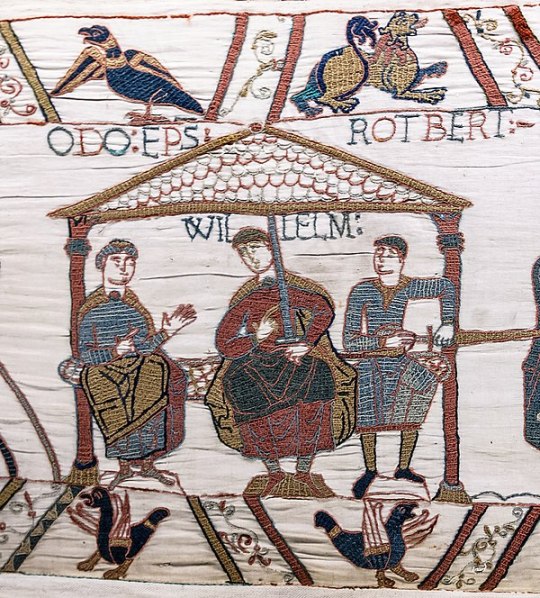

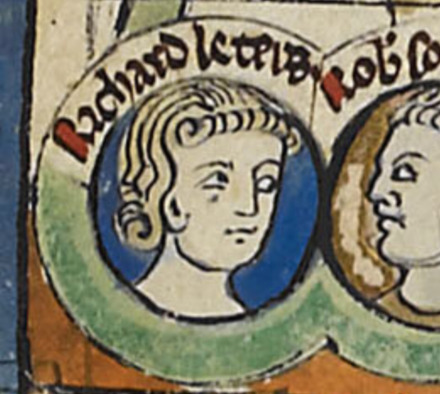
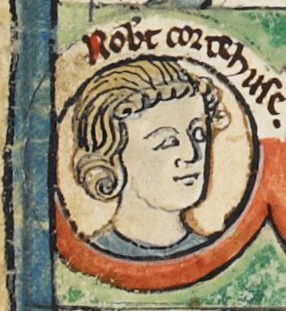
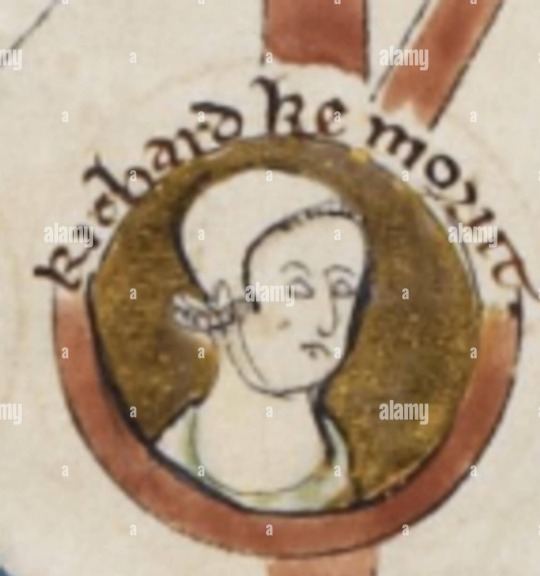
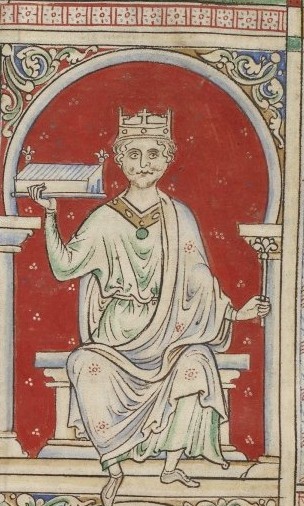

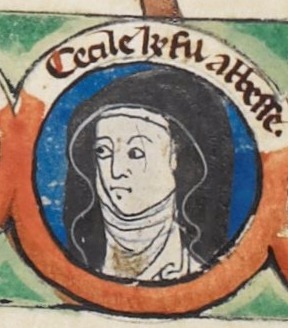


The Bastard Kings and their families
This is series of posts are complementary to this historical parallels post from the JON SNOW FORTNIGHT EVENT, and it's purpouse to discover the lives of medieval bastard kings, and the following posts are meant to collect portraits of those kings and their close relatives.
In many cases it's difficult to find contemporary art of their period, so some of the portrayals are subsequent.
1) William I of England (c. 1028 – 1087), son of Robert I of Normandy and Herleva of Falaise; with his brothers Odo of Bayeux (d. 1097) and Robert of Mortain (c. 1031–c. 1095), sons of Herleva of Falaise and her husband Herluin de Conteville
2) His father, Robert I of Normandy (1000 –1035), son of Richard II of Normandy and his wife Judith of Brittany
3) His uncle, Richard III of Normandy (997/1001 – 1027), son of Richard II of Normandy and his wife Judith of Brittany
4) His son, Robert II of Normandy (c. 1051 – 1134), son of William I of England and Matilda of Flanders
5) His son, William II of England( c. 1057 – 1100), son of William I of England and Matilda of Flanders
6) His son, Henry I of England (c. 1068 –1135), son of William I of England and Matilda of Flanders
7) His daughter, Cecily of Normandy (c. 1056 – 1126), daughter of William I of England and Matilda of Flanders
8) His daughter, Constance of Normandy (c. 1057/61– 1090), daughter of William I of England and Matilda of Flanders
9) His daughter, Adela of Normandy (c. 1067– 1137), daughter of William I of England and Matilda of Flanders
#jonsnowfortnightevent2023#asoiaf#a song of ice and fire#day 10#echoes of the past#historical parallels#medival bastard kings#bastard kings and their families#william i of england#william the conqueror#odo of bayeux#robert of mortain#robert i of normandy#richard iii of normandy#robert ii of normandy#william ii of england#henry i of england#cecily of normandy#adela of normandy#constance of normandy#canonjonsnow
9 notes
·
View notes
Text
Ages of French Queens at First Marriage
I have only included women whose birth dates and dates of marriage are known within at least 1-2 years, therefore, this is not a comprehensive list.
This list is composed of Queens of France until the end of the House of Bourbon; it does not include Bourbon claimants or descendants after 1792.
The average age at first marriage among these women was 20.
Ermentrude of Orléans, first wife of Charles the Bald: age 19 when she married Charles in 842 CE
Richilde of Provence, second wife of Charles the Bald: age 25 when she married Charles in 870 CE
Richardis of Swabia, wife of Charles the Fat: age 22 when she married Charles in 862 CE
Théodrate of Troyes, wife of Odo: age 14 or 15 when she married Odo in 882 or 883 CE
Frederuna, wife of Charles III: age 20 when she married Charles in 907 CE
Beatrice of Vermandois, second wife of Robert I: age 10 when she married Robert in 990 CE
Emma of France, wife of Rudolph: age 27 when she married Rudolph in 921 CE
Gerberga of Saxony, wife of Gilbert, Duke of Lorraine, and later of Louis IV: age 16 when she married Gilbert in 929 CE
Emma of Italy, wife of Lothair: age 17 when she married Lothair in 965 CE
Adelaide-Blanche of Anjou, wife of Stephen, Viscount of Gévaudan, Raymond III, Count of Toulouse, and later Louis V: age 15 when she married Stephen in 955 CE
Bertha of Burgundy, wife of Odo I, Count of Blois, and later Robert II: age 19 when she married Odo in 984 CE
Constance of Arles, third wife of Robert II: age 17 when she married Robert in 1003 CE
Anne of Kiev, wife of Henry I: age 21 when she married Henry in 1051 CE
Bertha of Holland, first wife of Philip I: age 17 when she married Philip in 1072 CE
Bertrade of Montfort, wife of Fulk IV, Count of Anjou, and second wife of Philip I: age 19 when she married Fulk in 1089 CE
Adelaide of Maurienne, second wife of Louis VI: age 23 when she married Louis in 1115 CE
Eleanor of Aquitaine, first wife of Louis VII and later Henry II of England: age 15 when she married Louis in 1137 CE
Adela of Champagne, third wife of Louis VII: age 20 when she married Louis in `1160 CE
Isabella of Hainault, first wife of Philip II: age 10 when she married Philip in 1180 CE
Ingeborg of Denmark, second wife of Philip II: age 19 when she married Philip in 1193 CE
Agnes of Merania, third wife of Philip II: age 21 when she married Philip in 1195 CE
Blanche of Castile, wife of Louis VIII: age 12 when she married Louis in 1200 CE
Margaret of Provence, wife of Louis IX: age 13 when she married Louis in 1234 CE
Isabella of Aragon, first wife of Philip III: age 14 when she married Philip in 1262 CE
Marie of Brabant, second wife of Philip III: age 20 when she married Philip in 1274 CE
Joan I of Navarre, wife of Philip IV: age 11 when she married Philip in 1284 CE
Margaret of Burgundy, wife of Louis X; age 15 when she married Louis in 1305 CE
Clementia of Hungary, second wife of Louis X: age 22 when she married Louis in 1315 CE
Joan II, Countess of Burgundy, wife of Philip V: age 15 when she married Philip in 1307 CE
Blanche of Burgundy, first wife of Charles IV: age 12 when she married Charles in 1308 CE
Marie of Luxembourg, second wife of Charles IV: age 18 when she married Charles in 1322 CE
Joan of Évreux, third wife of Charles IV: age 14 when she married Charles in 1324 CE
Bonne of Luxembourg, first wife of John II: age 17 when she married John in 1332 CE
Joan I, Countess of Auvergne, wife of Philip of Burgundy, and later John II: age 12 when she married Philip in 1338 CE
Joanna of Bourbon, wife of Charles V: age 12 when she married Charles in 1350 CE
Isabeau of Bavaria, wife of Charles VI: age 15 when she married Charles in 1385 CE
Marie of Anjou, wife of Charles VII: age 18 when she married Charles in 1422 CE
Charlotte of Savoy, second wife of Louis XI: age 9 when she married Louis in 1451 CE
Anne of Brittany, wife of Maximilian I, HRE, Charles VIII and later Louis XII: age 13 when she married Maximilian in 1490 CE
Joan of France, first wife of Louis XII: age 12 when she married Louis in 1476 CE
Mary Tudor, third wife of Louis XII: age 18 when she married Louis in 1514 CE
Claude of France, first wife of Francis I: age 15 when she married Francis in 1514 CE
Eleanor of Austria, wife of Manuel I of Portugal and later second wife of Francis I: age 20 when she married Manuel in 1518 CE
Catherine de' Medici, wife of Henry II: age 14 when she married Henry in 1533 CE
Mary, Queen of Scots, wife of Francis II: age 16 when she married Francis in 1558 CE
Elisabeth of Austria, wife of Charles IX: age 16 when she married Charles in 1570 CE
Louise of Lorraine, wife of Henry III: age 22 when she married Henry in 1575 CE
Margaret of Valois, first wife of Henry IV: age 19 when she married Henry in 1572 CE
Marie de' Medici, second wife of Henry IV: age 25 when she married Henry in 1600 CE
Anne of Austria, wife of Louis XIII: age 14 when she married Louis in 1615 CE
Maria Theresa of Spain, wife of Louis XIV: age 22 when she married Louis in 1660 CE
Marie Leszczyńska, wife of Louis XV: age 22 when she married Louis in 1725 CE
Marie Antoinette, wife of Louis XVI: age 15 when she married Louis in 1770 CE
38 notes
·
View notes
Photo

Neil Hamilton and Constance Bennett in What Price Hollywood? (George Cukor, 1932)
Cast: Constance Bennett, Lowell Sherman, Neil Hamilton, Gregory Ratoff, Brooks Benedict, Louise Beavers, Eddie Anderson. Screenplay: Jane Murfin, Ben Markson, Gene Fowler, Rowland Brown, based on a story by Adela Rogers St. John. Cinematography: Charles Rosher. Art direction: Carroll Clark. Film editing: Del Andrews, Jack Kitchin. Music: Max Steiner.
Bradley Cooper's 2018 film A Star Is Born is often called a remake of the films by that title starring Fredric March and Janet Gaynor in 1937, James Mason and Judy Garland in 1954, and Kris Kristofferson and Barbra Streisand in 1976. But all four of them can trace their origin to What Price Hollywood?, produced by David O. Selznick and directed by George Cukor in 1932. The name is different but the plot's the same: A successful man in the entertainment business discovers a young woman whom he helps become a star, but as her career ascends, his personal problems send him into a tailspin. if there's any doubt about the link with What Price Hollywood? and at least the first A Star Is Born, both were produced by Selznick. RKO, which released What Price Hollywood?, threatened to sue Selznick over the similarities, but decided against it. Selznick also asked Cukor to direct the 1937 film, but Cukor declined, so William A. Wellman took it on. But then Cukor went on to direct the 1954 Star Is Born. I don't think there's any direct connection between What Price Hollywood? and the 1976 version, produced by Streisand and Jon Peters and directed by Frank Pierson, but the lineage by then was obvious. The idea for the original film is a natural in a Hollywood that had become increasingly conscious of its own myth, and many real-life rising-star-falling-mentor analogs can be found in the history of the industry. Selznick commissioned Adela Rogers St. Johns, a former reporter for Photoplay and the Hearst newspapers, to write the story for the film, and various other hands turned it into a screenplay, though St. Johns and Jane Murfin claimed most of the credit when they were nominated for an Oscar for best original story. The film begins with a touch of screwball comedy when Max Carey (Lowell Sherman), an alcoholic director, encounters Mary Evans (Constance Bennett), a waitress at the Brown Derby looking for her chance to break into the movies. After some funny scenes involving Max's drunkenness and Mary's initial ineptness as an actress, the movie unfortunately begins to get serious. Though it's clear Mary really loves Max, when she becomes a big star she marries a society polo player, Lonny Borden (Neil Hamilton), after a somewhat cutesy courtship. But Borden is unhappy being "Mr. Mary Evans," and eventually storms out, though she's pregnant. Meanwhile, Max's decline continues, and after Mary rescues him from the drunk tank and promises to rehabilitate him, he shoots himself, thereby embroiling her in a headline-making scandal. But then Borden returns to apologize and all is well again. What keeps the film alive despite its clichés are the performances. Bennett is quite charming, and Sherman clearly models Max on John Barrymore, whom he knew well: He was married to Helene Costello, whose sister, Dolores, was Barrymore's third wife. The supporting cast includes Gregory Ratoff as the producer of Mary's films, Louise Beavers as (of course) her maid, and Eddie Anderson as Max's chauffeur -- five years before he became famous as Jack Benny's chauffeur, Rochester, on radio.
6 notes
·
View notes
Text
"To all intents and purposes she may be counted among the kings of France"

The hour that struck the death of Louis VIII was arguably the most critical in the history of the Capetian family. The new king, one day to be St Louis, was still a child. The trend of events in the previous two reigns had brought the higher nobility to realise that its independence would soon be seriously threatened. But a unique opportunity was raised to the regency of the queen-mother, Blanche of Castile, on the pretext that she was a woman and a foreigner. Yet this was not the first occasion on which the king's widow had acted as regent, nor the first on which a queen had played a part in politics. Philip Augustus had been the first Capetian not to involve his wife in the government of his realm. Before his time the queens of France had often intervened in affairs of state. Constance of Arles, not content with making married life difficult for Robert the Pious, had wanted to change the order of succession to the throne. She had led the opposition to Henri I, provoking and upholding his brothers against him, and she was perhaps responsible for the separation of Burgundy from the royal domain, to which Robert the Pious had joined it. Anna of Kiev, after the death of her husband Henri I, had been one of the regents, and it was only her second marriage, to Raoul de Crépy, that took her out of politics. Bertrada de Montfort's influence over Philip I had been notorious, and so had her hostility to the heir to the throne, whom she had even been accused of trying to poison. Adelaide of Maurienne, despite a physical personality before which Count Baldwin III of Hainault is said to have recoiled, had held considerable sway over Louis VI, procuring the disgrace of the chancellor, Etienne de Garlande, and egging on Louis to the Flemish adventure from which her brother-in-law, William Clito, was to profit so much. Eleanor of Aquitaine- as St Bernard had complained- had more power than anyone else over Louis VII as long as their marriage lasted. Louis VII's third wife, Adela of Champagne, had appealed to the king of England for help against her son Philip Augustus when he had sought to free himself of the tutelage of her brothers of Champagne. Later, reconciled with Philip, Adela had been regent during his absence from France on crusade. From the beginnings of Capet rule, the queens of France had enjoyed substantial influence over their husbands and over royal policy.
But Blanche of Castile was to play a greater role than any of her predecessors. To all intents and purposes she may be counted among the kings of France. For from 1226 until her death in 1252 she governed the kingdom. Twice she was regent: from 1226 to 1234, while Louis IX was a minor, and from 1248 to 1252 during his first absence on crusade. Between 1234 and 1248 Blanche bore no official title, but her power was no less effective. Severe in personality, heroic in stature, this Spanish princess took control of the fortunes of the dynasty and the kingdom in outstandingly difficult circumstances. For in 1226 there arose the most redoubtable coalition of great barons which the House of Capet ever had to face. Loyalty to the crown, so constant a feature of the past, seemed to be in eclipse. This was at any rate true of the barons who revolted, for they appear to have tried to seize the person of the young king himself- an attempt without parallel in Capetian history.
Blanche of Castile threw herself energetically into the struggle over her son and his throne. Taking her father-in-law, Philip Augustus, as her model, she won over half her enemies by craft, vigorously gave battle to the rest, and enlisted the alliance of the Church, including the Pope himself, and of the burgess class, which in marked fashion took the side of the royal family. Blanche was able to fend off Henry III of England, who tried to take the opportunity of recovering his ancestral lands, lost by John to Philip Augustus. She broke up the baronial coalition and reduced to submission the most dangerous of the rebels, Peter Mauclerc, Count of Brittany, and Raymond VII, Count of Toulouse. She adroitly took advantage of her victory to re-establish- this time definitively- the royal power in the south of France: her son Alphonse was married to the daughter and heiress of Raymond of Toulouse. The way was now open for the union of all Raymond's rich patrimony with the royal domain.
The Capetian monarchy emerged all the stronger from a crisis which had threatened to overwhelm it. Blanche felt it her duty not to rest on her laurels. After her son came of age she continued to make herself responsible for good and stable government. By the force of her example she drove home the lessons which Philip Augustus seems to have wanted to press upon his grandson when they had talked together. To Blanche's initiative must be credited the measures taken to suppress the dangerous revolt of Trencavel in Languedoc, as also those taken to defeat the coalition broken up after the battle of Saintes. On these occasions Louis IX did no more than carry out his mother's policy. When he went off on crusade, Blanche one more officially shouldered the government of the kingdom. She maintained law and order, prevented the further outbreak of war with England, and successfully pressed on with the policy which was to lead to the annexation of Languedoc. Likewise it was she who refurnished her son's crusade with men and money, and she took all the steps necessary for the safety of the kingdom when Louis was captured in Egypt.
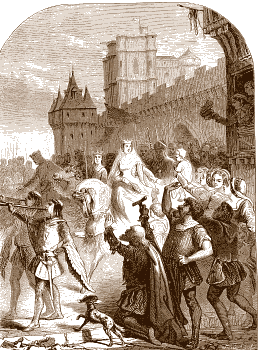
Robert Fawtier- The Capetian Kings of France- Monarchy and Nation (987-1328)
#xiii#robert fawtier#the capetian kings of france#blanche de castille#queens of france#regents#louis viii#louis ix#philippe ii#constance d'arles#robert ii#henri i#anne de kiev#philippe i#bertrade de montfort#adélaïde de savoie#louis vii#étienne de garlande#st bernard#aliénor d'aquitaine#adèle de champagne
4 notes
·
View notes
Text
Medieval Name Generator

Generate Names
Copy Selected
Clear Selection
Share on Twitter
Share on Facebook
List OF Medieval Names
Male Names1. Arthur
2. William
3. Henry
4. Richard
5. Edward
6. Geoffrey
7. Robert
8. John
9. Thomas
10. Philip
11. Stephen
12. Walter
13. Gilbert
14. Alfred
15. Baldwin
16. Simon
17. Hubert
18. Godfrey
19. Maurice
20. Roland
21. Lionel
22. Hugh
23. Guy
24. Baldwin
25. Bartholomew
26. Osbert
27. Reginald
28. Roderick
29. Benedict
30. Reynard
31. Edmund
32. Gilbert
33. Gerald
34. Baldwin
35. Baldwin
36. Roland
37. Bernard
38. Frederick
39. Conrad
40. Eustace
41. Fulk
42. Godwin
43. Harold
44. Herbert
45. Ivor
46. Ivo
47. Lucian
48. Melchior
49. Neville
50. NorbertFemale Names: 1. Eleanor
2. Matilda
3. Guinevere
4. Isabella
5. Beatrice
6. Catherine
7. Margaret
8. Elizabeth
9. Joan
10. Philippa
11. Rosalind
12. Agnes
13. Alice
14. Cecily
15. Constance
16. Maud
17. Emma
18. Felicity
19. Giselle
20. Heloise
21. Juliana
22. Agatha
23. Amabel
24. Audra
25. Clarice
26. Dionisia
27. Elfreda
28. Emeline
29. Felice
30. Gwendolen
31. Isolde
32. Leticia
33. Margery
34. Millicent
35. Nest
36. Odilia
37. Oriana
38. Petronilla
39. Rosamund
40. Sabina
41. Sybilla
42. Theodora
43. Ursula
44. Winifred
45. Ysabel
46. Adela
47. Avice
48. Blanche
49. Christiana
50. DenisS
How do I use it?
What makes masks stand out is their versatility. You must press hundreds of buttons before it can do its job; however, with a single button, the tool will begin generating names.Before clicking the generate button, enter the number of names you want, then click Generate Now.After you have the names, you can share them with your Facebook friends.Check out our latest toolsNew A I Pokémon Name Generator
Read the full article
0 notes
Photo




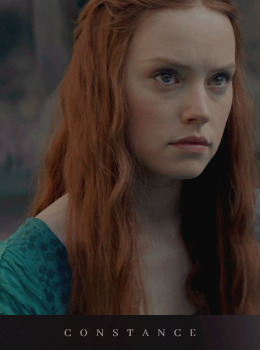

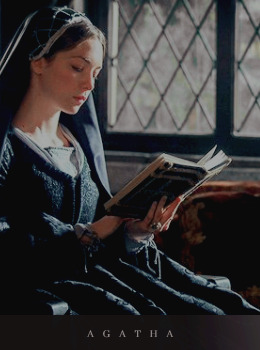
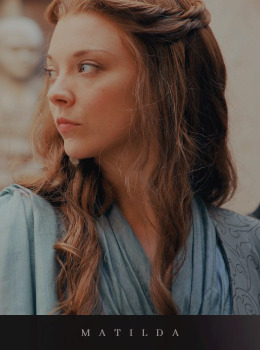
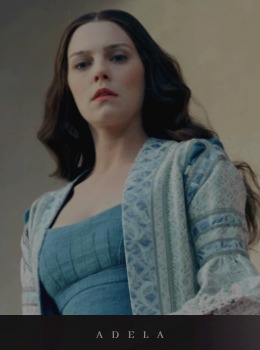

— Children of William I the Conqueror and Matilda of Flanders
#historyedit#william the conqueror#matilda of flanders#history#robert curthose#adeliza of normandy#cecilia of normandy#richard of normandy#constance of normandy#william ii#agatha of normandy#matilda of normandy#adela of normandy#adela of blois#henry i#house of normandy#medieval#fancast#pedioddramaedit#my edit#*housenormandy
131 notes
·
View notes
Text
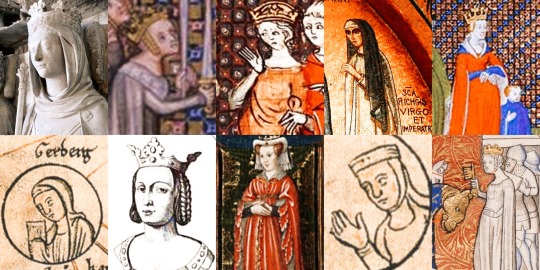
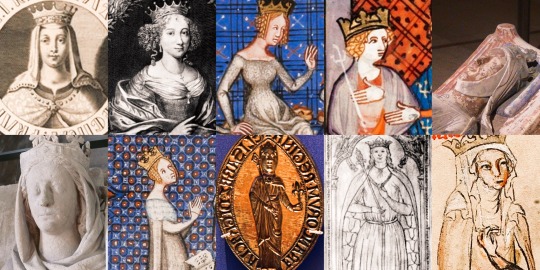




Every Queen of France Ever
Other posts in this series: Every Queen of England ever, Every English Princess ever
Richilde of Provence - Queen consort of West Francia from 870 to 877 (wife of Charles the Bald)
Adelaide of Paris - Queen consort of West Francia from October 6th 877 to April 10th 879 (wife of Louis the Stammerer)
Richardis of Swabia - Queen consort of West Francis from 884 to 887 (wife of Charles the Fat)
Richardis of Swabia - Queen consort of West Francis from 884 to 887 (wife of Charles the Fat)
Théodrate of Troyes - Queen consort of West Francia from 888 to 898 (wife of Odo of France)
Frederuna - Queen consort of West Francia from 907 to 917 (wife of Charles the Simple)
Eadgifu of Wessex - Queen consort of West Francia from 919 to 922 (wife of Charles the Simple)
Beatrice of Vermandois - Queen consort of West Francia from 922 to 923 (wife of Robert I)
Emma of France - Queen consort of West Francia from 923 to 935 (wife of Rudolph of France)
Gerberga of Saxony - Queen consort of West Francia from 939 to 954 (wife of Louis IV)
Emma of Italy - Queen consort of West Francia from 965 to 986 (wife of Lothair of France)
Adelaide of Aquitaine - Queen consort of the Franks from 987 to 996 (wife of Hugh Capet)
Rozala of Italy - Queen consort of the Franks from 996 to 996 (wife of Robert II)
Bertha of Burgundy - Queen consort of the Franks from 996 to 1000 (wife of Robert II)
Constance of Arles - Queen consort of the Franks from 1001 to 1031 (wife of Robert II)
Matilda of Frisia - Queen consort of the Franks from 1034 to 1044 (wife of Henry I)
Anne of Kiev - Queen consort of the Franks from May 19th 1051 to August 4th 1060 (wife of Henry I)
Bertha of Holland - Queen consort of the Franks from 1072 to 1092 (wife of Philip I)
Bertrade de Montfort - Queen consort of the Franks from May 15th 1092 to July 29th 1108 (wife of Philip I)
Adelaide of Maurienne - Queen consort of the Franks from 1115 to August 1st 1137 (wife of Louis VI)
Eleanor of Aquitaine - Queen consort of the Franks from August 1st 1137 to March 21st 1152 (wife of Louis VII)
Constance of Castile - Queen consort of the Franks from 1154 to October 4th 1160 (wife of Louis VII)
Adela of Champagne - Queen consort of the Franks from November 13th 1160 to September 18th 1180 (wife of Louis VII)
Isabella of Hainault - Queen consort of France from April 28th 1180 to March 15th 1190 (wife of Philip II)
Ingeborg of Denmark - Queen consort of France from August 15th 1193 to November 5th 1193 (wife of Philip II
Agnes of Merania - Queen consort of France from 1196 to 1200 (wife of Philip II)
Ingeborg of Denmark - Queen consort of France from 1200 to July 14th 1223 (wife of Philip II)
Blanche of Castile - Queen consort of France from July 14th 1223 to November 1226 (wife of Louis VIII)
Margaret of Provence - Queen consort of France from May 27th 1234 to August 25th 1270 (wife of Louis IX)
Isabella of Aragon - Queen consort of France from August 25th 1270 to January 28th 1271 (wife of Philip III)
Marie of Brabant - Queen consort of France from August 21st 1274 to October 5th 1285 (wife of Philip III)
Joan I of Navarre - Queen consort of France from October 5th 1285 to April 2nd 1305 (wife of Philip IV)
Margaret of Burgundy - Queen consort of France from 1314 to 1315 (wife of Louis X)
Clementia of Hungary - Queen consort of France from August 19th 1315 to June 5th 1316 (wife of Louis X)
Joan II of Burgundy - Queen consort of France from 1316 to 1322 (wife of Philip V)
Blanche of Burgundy - Queen consort of France from January 3rd 1322 to May 19th 1322 (wife of Charles IV)
Marie of Luxembourg - Queen consort of France from September 21st 1322 to March 26th 1324 (wife of Charles IV)
Joan of Évreux - Queen consort of France from July 5th 1324 to February 1st 1328 (wife of Charles IV)
Joan of Burgundy - Queen consort of France from April 1st 1328 to December 12th 1349 (wife of Philip VI)
Blanche of Navarre - Queen consort of France from January 29th 1350 to August 22nd 1350 (wife of Philip VI)
Joan I of Auvergne - Queen consort of France from 1350 to 1360 (wife of John II)
Joanna of Bourbon - Queen consort of France from April 8th 1364 to February 6th 1378 (wife of Charles V)
Isabeau of Bavaria - Queen consort of France from July 17th 1385 to October 21st 1422 (wife of Charles VI)
Marie of Anjou - Queen consort of France from December 18th 1422 to July 14th 1461 (wife of Charles VII)
Charlotte of Savoy - Queen consort of France from July 22nd 1461 to August 30th 1483 (wife of Louis XI)
Anne of Brittany - Queen consort of France from December 6th 1491 to April 7th 1498 (wife of Charles VIII)
Joan of France - Queen consort of France from April 1498 to December 15th 1498 (wife of Louis XII)
Anne of Brittany - Queen consort of France from January 8th 1499 to January 9th 1515 (wife of Louis XII)
Mary Tudor - Queen consort of France from October 9th 1514 to January 1st 1515 (wife of Louis XII)
Claude of France - Queen consort of France from January 1st 1515 to July 20th 1524 (wife of Francis I)
Eleanor of Austria - Queen consort of France from July 4th 1530 to March 31st 1547 (wife of Francis I)
Catherine de' Medici - Queen consort of France from March 31st 1547 to July 10th 1559 (wife of Henry II)
Mary Stuart - Queen consort of France from July 10th 1559 to December 5th 1560 (wife of Francis II)
Elisabeth of Austria - Queen consort of France from November 26th 1570 um May 30th 1574 (wife of Charles IX)
Louise of Lorraine - Queen consort of France from February 15th 1575 to August 2nd 1589 (wife of Henry III)
Margaret of Valois - Queen consort of France from August 2nd 1589 to 1599 (wife of Henry IV)
Marie de' Medici - Queen consort of France from December 17th 1600 to May 14th 1610 (wife of Henry IV)
Anne of Austria - Queen consort of France from November 24th 1615 to May 14th 1643 (wife of Louis XIII)
Maria Theresa of Spain - Queen consort of France from June 9th 1660 to July 30th 1683 (wife of Louis XIV)
Marie Leszczyńska - Queen consort of France from September 4th 1725 to June 24th 1768 (wife of Louis XV)
Marie Antoinette - Queen consort of France from May 10th 1774 to September 21st 1792 (wife of Louis XVI)
Maria Amalia of Naples and Sicily - Queen consort of the French from August 9th 1830 to February 24th 1848 (wife of Louis Philippe I)
#historical women#french history#anne of brittany#mary tudor queen of france#claude of france#eleanor of austria#eleanor of aquitaine#catherine de medici#mary queen of scots#marie antoinette
64 notes
·
View notes
Text
“When Stephen-Henry left again for the Holy Land late in 1100, his sons were still boys. Adela thus continued to rule as countess. Though she was not accorded the title of regent in any surviving source, Adela’s ruling powers were acknowledged in the dating clause of two charters issued by others, one in 1102, “when count Stephen [then in the Holy Land] and his wife Adela were ruling” the other in 1107, “when countess Adela was ruling and present.” In 1101 and 1102, Adela and three of her sons met with her brother-in-law, Hugh of Troyes, and his wife Constance, at Epernay and Coulommiers, where they consented to Hugh’s and Constance’s donations to the monks at Molesme. In seeking consent from the wife of his absent older brother, Hugh acknowledged Adela’s place in the Thibaudian family as a whole.
By 1103 Adela had entrusted her second son, Thibaut (then about ten), to Hugh and Constance (still childless after almost a decade of married life) to be groomed as his paternal uncle’s potential successor. Hugh’s lands and titles would thus be kept in Thibaudian hands while Adela was relieved of the responsibility for her son’s military training. Such family solidarity continued after Hugh’s and Constance’s marriage was annulled and both partners remarried. The heir-designate William also came of age in about 1103, the year news was received of Stephen-Henry’s death (in May 1102) on crusade. William, married in 1104, continued to act as heir-designate until 1107, when Thibaut was knighted and chosen by Adela to be their father’s principal heir.
Even so, Adela continued to exercise comital authority after her oldest sons came of age. Though young Thibaut played an increasingly active role in affairs, especially during the war-torn second decade of the twelfth century, charters reveal that Adela still acted with full authority without her son until she retired to a monastery in the spring of 1120. The chronicler Robert of Torigni depicted Adela as nobly ruling while her sons were less able to govern; by linking their full adulthood to Adela’s taking the veil, he indicated that she ruled until that moment. Indeed, in 1128 Thibaut himself stated that the lordship of the county of Chartres did not come into his hands until his mother took monastic vows. Though Thibaut, when in his early twenties, occasionally acted alone there, it was simply because Adela was active elsewhere in the family’s domains.
Thus it appears that the countess, like her male peers, simply associated her sons in comital rule until she chose to devote herself to God. William and Thibaut had three younger brothers. Stephen probably came of age around 1109, about two years after the last dated appearance of his brother Odo, who was apparently always of fragile health and died in his teens. Adela employed a doctor to care for Odo and endowed anniversary prayers for his salvation. She dedicated to God her youngest son, Henry, who was most likely conceived between Stephen-Henry’s Holy Land campaigns, at the Cluniac priory of La Charite-sur-Loire, near the family’s lands in northeastern Berry, shortly after his father’s death. Adela also had at least one daughter, named Matilda like Adela’s own queenly mother.
She may well have been the mother of two other girls, Agnes and one whose name is not known, though it is possible that she acted simply as their stepmother. None of these girls appear by name in any extant document during their childhood years; eventually they all came to play important roles in Adela’s political alliance building. After news of her husband’s death reached France, Adela and her brother-in-law Hugh made several pious bequests to endow anniversaries for Stephen. Adela’s grants were mostly minor and frequently made when she was treating other comital affairs. While Adela thus arranged for monks long patronized by the Thibaudians to pray for her husband, she did not allow her religious concern for his salvation to overwhelm her sense of practical administrative realities.
At the same time, she endowed prayers for herself and her children. Nor did she forget her own parents in other bequests. Like Stephen-Henry, Adela felt primarily responsible for the spiritual well-being of members of her conjugal family, but also showed concern for the salvation of both natal and affinal kin. Adela appears to have been most active in the years 1101-9, when in her thirties (though this may simply be an impression arising from the vagaries of document survival). Twenty-five charters dated to 1101-9 and another fourteen documents most likely datable to this time testify to her activities during these years, compared to eighteen documents datable to the next decade. Adda’s actions are also described in letters, chronicles, and other narrative texts. In addition, Adda suffered at least two serious illnesses, first sometime 1100-1102, then in the spring of 1105.
It was perhaps in 1100-1102 that she was miraculously healed at Rebais through the relics of Saint Aile, after the best French, Norman, and “overseas” doctors failed to cure her life-threatening fevers. The countess perambulated through her widespread domains until her retirement. She held court to settle disputes, consented to donations by comital followers, founded and regulated fairs, and sponsored limited ecclesiastical reform. She acted as lord to lay followers as well as cultivating relations with traveling churchmen, her multiple diocesan bishops, and religious houses of various orders, several of which formally acknowledged her lordly role as protector. She gave special attention to expanding the new settlement of Francheville and organized similar clearance and settlement programs elsewhere in the Thibaudian domains.
These ventures, together with her fostering of trade, show how Adela worked to increase comital revenues by promoting economic growth. Household officials, some of whom she herself appointed, and men of brightly rank with landed estates in one region of the Thibaudian domains often accompanied her to other parts of her domains, showing that she, like her father-in-law and husband before her, could rely on the service of powerful men from across the family’s multiple counties. And, like earlier counts, the countess continued to rely on local agents resident in specific locations. Contemporary observers acknowledged that Adela exercised the same authoritative powers as her male peers. Orderic Vitalis reveals that she had the authority to command fighting men when he described how the countess ordered one hundred knights to take the field with the co-king Louis.
In his letters, Ivo of Chartres referred to Adela’s princely rule (principatus), the peace oaths she swore, and precepts and privileges she issued. He also discussed her jurisdiction over monasteries and her judgment at the comital court in a land dispute between castellans. The poet-prelate Hildebert, bishop of Le Mans, praised Adela as an able administrator who embodied all that was required for governing in a letter urging her to cultivate clemency when exercising her princely power to punish others. In another letter he asked her to deploy her protective power (patrocinium) by granting him an armed escort. Laymen also looked to Adela as their lord (dominus/domina) understood as one who had the right to grant and oversee the transmission of fiefs and honors, as well as the authority to settle disputes in which people holding such properties became involved.”
- Kimberly A. LoPrete, “Adela of Blois: Familial Alliances and Female Lordship.” in Aristocratic Women in Medieval France
#adela of blois#kimberly a. loprete#aristocratic women in medieval france#medieval#history#high middle ages#french#noblewomen
17 notes
·
View notes
Photo
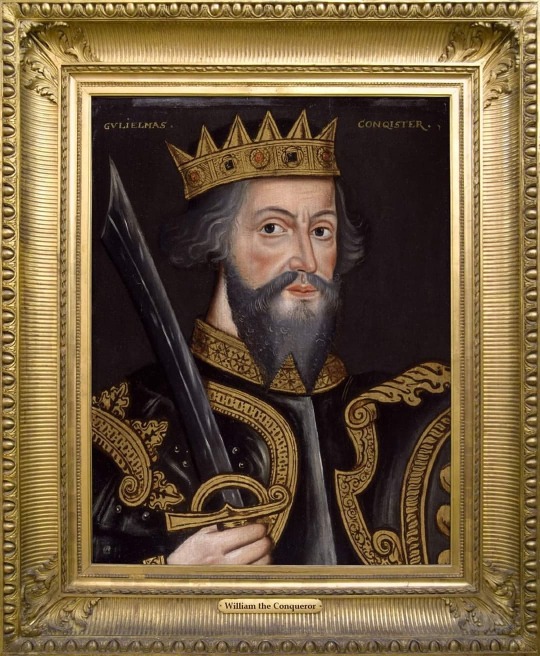
The age of the Anglo-Saxon kings has passed, so now we move on to the Conqueror that I’m sure you’ve heard of? 🙂
.
William the Conqueror (or William I)
______________
.
Reign: 25 December 1066 – 9 September 1087
Coronation: 25 December 1066.
Born: about 1028, Falaise, Duchy of Normandy.
Parents: Robert the Magnificent (1000 – 1035), Duke of Normandy & Herleva of Falaise.
House of: Normandy.
_______________
.
Marriage & children;
.
William married Matilda of Flanders in 1051/52. Matilda of Flanders (c. 1031 – 2 November 1083). Matilda was born into the House of Flanders, the second daughter of Count Baldwin V of Flanders & Adela of France.
.
They had at least nine children. The birth order of the sons is clear, but no source gives the relative order of birth of the daughters.
.
Robert Curthouse was born between 1051 & 1054, died in 1134. Duke of Normandy, married Sybilla, daughter of Geoffrey, Count of Conversano.
.
Richard was born before 1056, died around 1075.
.
William was born between 1056 & 1060, died 2 August 1100. King of England.
.
Henry was born in late 1068, died 1 December 1135. King of England, married Edith, daughter of Malcolm III of Scotland. His second wife was Adeliza of Louvain.
.
Adeliza (or Adelida, Adelaide) died before 1113, reportedly betrothed to Harold Godwinson, probably a nun of Saint Léger at Préaux.
.
Cecilia (or Cecily) was born before 1066, died 1127, Abbess of Holy Trinity, Caen.
.
Matilda was born around 1061, died perhaps about 1086. Mentioned in Domesday Book as a daughter of William.
.
Constance died 1090, married Alan IV, Duke of Brittany.
Adela died 1137, married Stephen, Count of Blois.
(Possibly) Agatha, the betrothed of Alfonso VI of León & Castile
____________________
.
Died: 9 September 1087 (aged about 59), Priory of Saint Gervase, Rouen, Duchy of Normandy.
Burial: Saint-Étienne de Caen, Normandy.
.
Successor: William II (son)
.
Use the following hashtag to view the full set posted so far #kingsandqueensofgreatbritain 👍
.
Swipe to see what’s new in our British Monarchy Blog Shop 👀
.
.
.
#WilliamI #WilliamtheConqueror #Royalhistory #Britishmonarchy #Normans (at Normandy, France)
https://www.instagram.com/p/CRrk43BMzcA/?utm_medium=tumblr
7 notes
·
View notes
Text
Ages of French Princesses at First Marriage
I have only included women whose birth dates and dates of marriage are known within at least 1-2 years, therefore, this is not a comprehensive list.
This list is composed of princesses of France until the end of the House of Bourbon; it does not include Bourbon claimants or descendants after 1792.
The average age at first marriage among these women was 15.
Judith of Flanders, daughter of Charles the Bald: age 12 when she married Æthelwulf, King of Wessex in 856 CE
Rothilde, daughter of Charles the Bald: age 19 when she married Roger, Count of Maine in 890 CE
Emma of France, daughter of Robert I: age 27 when she married Rudolph of France in 921 CE
Matilda of France, daughter of Louis IV: age 21 when she married Conrad I of Burgundy in 964 CE
Hedwig of France, daughter of Hugh Capet: age 26 when she married Reginar IV of Hainault in 996 CE
Gisela of France, daughter of Hugh Capet: age 26 when she married Hugh of Ponthieu in 994 CE
Hedwig of France, daughter of Robert II: age 13 when she married Renauld I, Count of Nevers in 1016 CE
Adela of France, daughter of Robert II: age 18 when she married Richard III of Normandy in 1027 CE
Constance of France, daughter of Philip I: age 16 when she married Hugh I, Count of Troyes in 1094 CE
Cecile of France, daughter of Philip I: age 9 when she married Tancred, Prince of Galilee in 1106 CE
Constance of France, daughter of Louis VI: age 14 when she married Eustace IV, Count of Boulogne in 1140 CE
Marie of France, daughter of Louis VII: age 14 when she married Henry I, Count of Champagne, in 1159 CE
Alice of France, daughter of Louis VII: age 14 when she married Theobald V, Count of Blois in 1164 CE
Margaret of France, daughter of Louis VII: age 14 when she married Henry the Young King in 1172 CE
Alys of France, daughter of Louis VII: age 35 when she married William IV of Ponthieu in 1195 CE
Agnes of France, daughter of Louis VII: age 8 when she married Alexios II Komnenos in 1180 CE
Marie of France, daughter of Philip II: age 13 when she married Philip I of Namur in 1211 CE
Isabella of France, daughter of Louis IX: age 14 when she married Theobald II of Navarre in 1255 CE
Blanche of France. daughter of Louis IX: age 16 when she married Ferdinand de la Cerda in 1269 CE
Margaret of France, daughter of Louis IX: age 16 when she married John I, Duke of Brabant in 1270 CE
Agnes of France, daughter of Louis IX: age 19 when she married Robert II, Duke of Burgundy in 1279 CE
Blanche of France, daughter of Philip III: age 22 when she married Rudolf III of Austria in 1300 CE
Margaret of France, daughter of Philip III: age 20 when she married Edward I of England in 1299 CE
Isabella of France, daughter of Philip IV: age 13 when she married Edward II of England in 1308 CE
Joan II of Navarre, daughter of Louis X: age 6 when she married Philip III of Navarre in 1318 CE
Joan III, daughter of Philip V: age 10 when she married Odo IV, Duke of Burgundy in 1318 CE
Margaret I, daughter of Philip V: age 10 when she married Louis I of Flanders in 1320 CE
Isabella of France, daughter of Philip V: age 11 when she married Guigues VIII of Viennois in 1323 CE
Blanche of France, daughter of Charles IV: age 17 when she married Philip, Duke of Orleans in 1345 CE
Joan of Valois, daughter of John II: age 9 when she married Charles II of Navarre in 1352 CE
Marie of France, daughter of John II: age 20 when she married Robert I, Duke of Bar in 1364 CE
Isabella, daughter of John II: age 12 when she married Gian Geleazzo Visconti in 1360 CE
Catherine of France, daughter of Charles V: age 8 when she married John of Berry, Count of Montpensier in 1386 CE
Isabella of Valois, daughter of Charles VI: age 6 when she married Richard II of England in 1396 CE
Joan of France, daughter of Charles VI: age 5 when she married John V, Duke of Brittany in 1396 CE
Michelle of Valois, daughter of Charles VI: age 14 when she married Philip III, Duke of Burgundy in 1409 CE
Catherine of Valois, daughter of Charles VI: age 19 when she married Henry V of England in 1420 CE
Catherine of France, daughter of Charles VII: age 12 when she married Charles I, Duke of Burgundy in 1440 CE
Joan of France, daughter of Charles VII: age 12 when she married John II , Duke of Bourbon in 1447 CE
Yolande of Valois, daughter of Charles VII: age 18 when she married Amadeus IX, Duke of Savoy in 1452 CE
Magdalena of Valois, daughter of Charles VII: age 18 when she married Gaston, Prince of Viana in 1461 CE
Anne of France, daughter of Louis XI: age 12 when she married Peter of Bourbon in 1473 CE
Joan of France, daughter of Louis XI: age 12 when she married Louis XII in 1476 CE
Claude of France, daughter of Louis XII: age 15 when she married Francis I in 1514 CE
Renée of France, daughter of Louis XII: age 18 when she married Ercole II d'Este in 1528 CE
Madeleine of Valois, daughter of Francis I: age 17 when she married James V of Scotland in 1537 CE
Margaret of Valois, daughter of Francis I: age 36 when she married Emmanuel Philibert, Duke of Savoy in 1559 CE
Elisabeth of Valois, daughter of Henry II: age 13 when she married Philip II of Spain in 1559 CE
Claude of Valois, daughter of Henry II: age 12 when she married Charles III, Duke of Lorraine in 1559 CE
Margaret of Valois, daughter of Henry II: age 19 when she married Henry IV in 1572 CE
Elisabeth of France, daughter of Henry IV: age 13 when she married Philip IV of Spain in 1615 CE
Christine of France, daughter of Henry IV: age 13 when she married Victor Amadeus I, Duke of Savoy in 1619 CE
Henrietta Maria of France, daughter of Henry IV: age 16 when she married Charles I of England in 1625 CE
Louise Élisabeth of France, daughter of Louis XV: age 12 when she married Philip, Duke of Parma in 1739 CE
Marie-Thérèse, daughter of Louis XVI: age 21 when she married Louis Antoine, Duke of Angoulême in 1799 CE
20 notes
·
View notes
Text
Octavius Capp: Son of Caesar -- RESOURCES
Here’s a read more since this list turned out obnoxiously long.
The Sims Wiki
Mentioned Sims
Octavius Capp
Julius Caesar
Calpurnia Caesar
Scribonia Capp
Contessa Capp
Cleopatra Capp
Antony Capp
William Norman
Mathilde Norman
Henry Anjou
Eleanor Anjou
Richard Norman
Anne Norman
Albany Capp
Cornwall Capp
Mentioned Families
Capp Family
Game Mechanics
Marriage
Adoption
Historical Sources
Mentioned Historical Figures
Emperor Augustus/Gaius Octavius
Gaius Julius Caesar
Calpurnia
Julia Caesaris
Cornelia
Caesarion
Cleopatra VII Philopater
Gaius Octavius
Atia Balba Caesonia
Julia Caesaris Minor
Octavia Major
Octavia Minor
Marcus Antonius
Scribonia
Alexander Helios
Cleopatra Selene II
Ptolemy Philadelphus
Julia the Elder
William I, King of England
Matilda of Flanders
Robert II, Duke of Normandy
Richard of Normandy
Adeliza
Cecilia
William II, King of England
Constance, Duchess of Brittany
Adela, Countess of Blois
Henry I, King of England
Henry II, King of England
Eleanor of Aquitaine
William IX, Count of Poitiers
Henry the Young King
Matilda, Duchess of Saxony
Richard I, King of England
Geoffrey II, Duke of Brittany
Eleanor, Queen of Castile
Joan, Queen of Sicily
John, King of England
Richard III, King of England
Anne Neville
Edward of Middleham
Gens
Octavia gens
Julia gens
Shakespeare Sources
Julius Caesar
Act I, Scene ii on Sparknotes
Other
Roman naming conventions (Praenomen, Nomen, Cognomen)
Lineage (Matrilineality, Patrilineality)
2 notes
·
View notes
Note
hello! I hope it’s not too random of a question but I’m falling back down the rabbit hole of wilde (1997) and my highly caffeinated brain is now worried about the little line of “I can’t help but notice the statue is in your bedroom”—is that a bit of a dig at Constance? (like yes, rational brain, it’s a movie, calm down) but I always thought Robbie was fond of Constance in his own way, or maybe I’m misinterpreting it?? anywho it’s a gorgeous movie and im dying over it
It is absolutely a gorgeous movie. i cant remember exactly what part you’re referencing, but as for Robbie’s actual feelings towards Constance, I think he was fond of her in a way. He wrote to Adela Schuster not long after Oscar’s death, “He really did not understand how cruel he was to his wife.” and i think i can remember an anecdote on one occasion about robbie telling him that one letter wasnt enough of an apology to her. as far as i know they were largely civil and friendly towards each other prior to oscar’s conviction
but there’s the whole drama of the life interest when oscar went to jail, which i have mixed feelings about but i think ultimately reveal that altho Robbie liked Constance and seemed to empathize with her, it’s not a regard that went very deep. it’s like a complex legal situation i dont fully recall the details of involving the financial rights of married women at the time but basically when Oscar went to prison and went bankrupt, Constance’s marriage settlement was part of the estate that went up for sale to pay his creditors, and the most important part of that was the annual interest on the settlement, which was Constance’s while she was alive.
Constance wanted to buy it herself so upon her death--and her health at the time was deteriorating rapidly--the entirety of the interest would be conferred on the children, but Robbie and another of their friends, More Adey, hatched a plan to buy it too, for Oscar. Their idea was to give part of it to Oscar and part to the boys, but Constance wanted sole parental rights over them bc she didn’t trust Oscar to care for them, which Robbie and Adey refused to agree to, even when Constance offered to give part of the money each year to Oscar and the remainder to the boys, an offer Oscar instructed Robbie to accept. He refused, however, and with Adey, against the urging of both Oscar and some of their other friends, bid against Constance and ultimately won. this whole affair pretty much destroyed all the attempts constance and oscar were making at reconciliation and pissed both of them off, tho to my knowledge oscar directed most of his anger at Adey rather than Robbie
(in the end it didnt even matter, because constance got a court to give her guardianship over the boys, and threatened to drag oscar through a lengthy and likely very public divorce preceding on the grounds of sodomy to regain control over the interest, which Ross and Adey were obviously anxious to avoid bc all of this was to the purpose of Oscar’s benefit. So they signed the interest back over to Constance)
5 notes
·
View notes
Text
Apple of his father's eye

Whatever Louis's failings in the eyes of his first wife, he later proved a good husband and father. There are no unfavourable comments on his second and third marriages, which both produced offspring. The second marriage, to Constance of Castile, added two daughters to the two by Eleanor. But there is no doubt that when his third wife, Adela of Champagne gave birth in 1165, the God-given son became the apple of his father's eye. Louis resisted the Capetian practice of associating his son in government with him. Perhaps the security of his position made it unnecessary. Perhaps, in 1172, when Henry archbishop of Reims suggested a coronation, and with papal support, Louis thought his seven-year old son too young. Louis had no doubts that Philip should be his heir. In 1179, when ill, Louis called an assembly in Paris. There he announced his intention of having Philip crowned on the feast of Assumption, on 15 August. These plans, however, were dramatically interrupted. Philip went hunting near Compiègne. Chasing a boar, he became lost alone in the woods. Found by a charcoal-burner, Philip was led to safety, but a night in the open, two days without food, and the shock of the whole episode, darnaged his health. The prince became ill to the point where death seemed imminent. The coronation was postponed.
Now Louis conducted himself as the caring father, weeping profusely, sighing night and day, inconsolable. One night the murdered Thomas Becket appeared before him, proc1aiming: 'Our Lord Jesus Christ sends me as your servant, Thomas the martyr of Canterbury, in order that you should go to Canterbury, if your son is to recover.' Louis's counsellors tried to dissuade the ageing king from a journey into the lion's den, but he overrode all opposition and went, accompanied by the counts of Flanders, Guisnes and Louvain, arriving at Dover on 22 August. He was met by Henry II who, whatever his suspicions, escorted Louis to Canterbury and treated him as an honoured guest. Louis spent two days praying, 'a humble and devout suppliant', and then returned home. Philip recovered rapidly and was crowned at Reims on 1 November. The episode added to Louis's pious reputation, though the journey had probably been undertaken less for prestige than from love of his son.
The Norman chronicler, Robert of Torigny, says that in 1179 there were great winds and forecasts of impending calamities. The effort of the journey had been too much for the sixty-year-old monarch. He went into decline, suffering a stroke which left him paralysed and unable to speak. Philip was installed as king and immediately took an active role. Louis VII became no more than 'a spectator in the last year of the reign'. His incapacity was such that his personal seal was taken away. He died in September 1180, with his fifteen-year-old son still recuperating. The father was buried at his own foundation, the Cistercian house of Barbeau. The inscription on his tomb, which Philip may weIl have taken to heart, read:
You who survive him are the successor of his dignity;
You diminish his line if you diminish his renown.
Jim Bradbury - Philip Augustus, King of France, 1180-1223
#xii#jim bradbury#philip augustus king of france 1180-1223#louis vii#philippe ii#father and son#adèle de champagne#constance de castille#aliénor d'aquitaine
2 notes
·
View notes
Photo

Under the cut you’ll find 675 FEMININE NAMES all compiled by me !! I will most likely be updating this and my other lists at some point and would be more than willing to post more specific lists if anyone wants them !! Please like or reblog if this was helpful !!
Abilene, Acacia, Ada, Adalia, Adalind, Adelina, Adeline, Adela, Adele, Adriana, Agnes, Aimee, Aislinn, Aja, Alana, Alba, Alessia, Alexa, Alexandra, Alexandria, Alexandrine, Aliyah, Allora, Alma, Almira, Althea, Alva, Amber, Amabel, Amara, Amelie, Amethyst, Amina, Anastasia, Antoinette, Andromeda, Anika, Anissa, Annabel, Annabel-Lee, Anne, Annette, Annie, Anniston, Appoline, Apollinia, Apollonia, Ara, Arabella, Araminta, Ariadne, Ariana, Arianne, Ariella, Asena, Astra, Astrid, Athena, Audrey, Audrina, Autumn, Aurelia, Aurora, Austen, Ava, Avalee, Avalon, Averill, Aviana, Ayla, Aylee, Azalea, Azaria.
Bambi, Bardot, Beatrice, Beatrix, Becky, Bee, Bellatrix, Belle, Benedette, Benilde, Bernadette, Bess, Beth, Betsey, Beverly, Bexley, Bijou, Bindie, Birdie, Blair, Blossom, Bluebell, Blythe, Bonnie, Brenna, Bria, Briar, Bridget, Briella, Brielle, Brinley, Bristol, Brooke, Bronwyn, Buffy.
Cadence, Calla, Callie, Callista, Camila, Camille, Cara, Cariad, Carmen, Carol, Carolina, Caroline, Carolyn, Carrie, Cassandra, Cassiopeia, Cecilia, Cecily, Celeste, Celestia, Celine, Chanel, Charity, Charlotte, Cher, Cherie, Cheryl, Cheyenne, Chloe, Claire, Clara, Clarity, Claudia, Claudine, Clea, Cleo, Clover, Colette, Colleen, Constance, Connie, Copeland, Cora, Coral, Coralia, Coraline, Cordelia, Coretta, Corinna, Corinne, Corisande, Corliss, Cornelia, Corvina, Cosette, Cressida, Cynthia, Cyra.
Dahlia, Dahliana, Daisy, Damara, Dara, Darcy, Darla, Darlene, Daphne, Davina, Dawn, Dee, Delia, Delilah, Delphi, Delphine, Denise, Desiree, Desdemona, Desi, Destiny, Diana, Diane, Dinah, Dixie, Dolly, Dorothea, Dorothy, Dot, Drusilla.
Eadlyn, Eartha, Eden, Edie, Edina, Edith, Effie, Eileen, Elara, Eleanor, Eleanora, Elena, Eliana, Elisabeth, Elise, Elizabeth, Ella, Elle, Elodie, Eloise, Elowen, Elora, Elsie, Emalyn, Embla, Emilia, Emma, Emmeline, Emmy, Enid, Eponine, Erica, Erin, Esme, Estelle, Esther, Ethel, Ettie, Everly, Eva, Evangeline, Evanora, Evelina, Evelyn, Everly, Evita, Eyre.
Fae, Faith, Fallon, Fancy, Fannie, Fantine, Farah, Fawn, Faye, Felicity, Fern, Francine, Fran, Finnea, Fleur, Flora, Florence, Francesca, Franny, Frankie, Frida, Freya, Fyodora.
Gabriella, Gaia, Gail, Garbo, Gardenia, Gemma, Geneva, Geneve, Genevieve, Gennifer, Georgeanne, Georgia, Gia, Giana, Gigi, Gillian, Gina, Ginevra, Ginger, Ginny, Giordana, Giovanna, Gisele, Guilieta, Guilia, Guiliana, Gladys, Glenda, Glinda, Gloriana, Glory, Goldie, Goldeheve, Grace, Gracelyn, Gracie, Greer, Greta, Gretchen, Griselda, Guinevere, Gwenora, Gwendolyn, Gwenny.
Hadley, Haddie, Hadiya, Halle, Hallie, Halston, Hanna, Hannah, Harmony, Harper, Harriet, Hattie, Hazel, Helen, Helena, Heloise, Henrietta, Henna, Hera, Hermia, Hermione, Hester, Hettie, Holly, Honey, Honora, Hope.
Ida, Ilana, Ilyana, Imogen, Indie, Inessa, Ingrid, Iphegenia, Iris, Irene, Isabeau, Isabella, Isabelle, Isla, Isobel, Isolde, Ivana, Ivory, Ivy.
Jacinta, Jackie, Jada, Jade, Jane, Janie, Jasey, Jasey-Rae, Jeana, Jeanie, Jedda, Jennifer, Jennie, Jenny, Jessa, Jessamine, Johanna, Jolene, Jolie, Joplin, Josie, Josephine, Journey, Joy, Judith, Judy, Julia, Julie, Juliet, Juniper, Juno.
Kaia, Kalani, Kara, Karen, Karolina, Kate, Kathleen, Katherine, Kayla, Kaylee, Kedzie, Keely, Kelby, Kelsey, Kendra, Kenna, Kennedy, Kiara, Kimberly, Kinsley, Kitty, Kristina, Kyra.
Laela, Lara, Laura, Laurel, Lauren, Lavinia, Leah, Leia, Leila, Lena, Lenora, Leonora, Letitia, Liana, Liberty, Lila, Lilo, Lilia, Lilith, Lily, Lindsey, Livia, Lois, Lola, Loretta, Loral, Lorelei, Lorena, Lorraine, Lottie, Lovisa, Lucia, Lucille, Lucy, Ludovica, Luna, Lulu, Lumi, Lux, Lydia, Lynn, Lyra.
Macy, Madeleine, Maia, Mae, Maeve, Maggie, Magnolia, Malia, Marcella, Maren, Margaret, Margot, Martha, Maria, Marie, Marigold, Marilyn, Marina, Marissa, Marisol, Marlene, Marnie, Mary, Matilda, Maude, Maureen, Maxine, Meadow, Melody, Melinda, Mercy, Merritt, Mia, Michelle, Millicent, Minerva, Minnie, Mira, Miriam, Moira, Molly, Mona, Morrigan.
Nadia, Nadine, Nancy, Naomi, Narcissa, Naressa, Natalia, Natalie, Naya, Nellie, Nettie, Nia, Nicola, Nicole, Nicoletta, Nikita, Nina, Nikki, Noelle, Norah, Nova, Nyla.
Oara, Octavia, Odette, Odessa, Odyssesia, Odilia, Odina, Olita, Olive, Olivia, Olympia, Olwen, Opal, Ophelia, Oona, Orelia, Oriana, Orla, Orlena, Orpha, Ottoline, Ovalia.
Paige, Paisley, Pam, Pamela, Pandora, Patricia, Pearl, Peggy, Penelope, Petra, Persephone, Phoebe, Piper, Pippa, Pixie, Priscilla, Priya, Prudence, Polly, PollyAnna, Poppy, Posey.
Raina, Ravena, Regina, Rey, Rhea, Rhiannon, Romilly, Romy, Rosa, Rosalie, Rosemary, Rowena, Roxanne, Ruby, Ruth, Ruthie.
Sabrina, Sadie, Safiya, Sally, Samantha, Samara, Samira, Sara, Sarah, Savannah, Scarlett, Selene, Serafine, Seraphina, Serena, Sia, Sienna, Sierra, Siobhan, Skye, Sofia, Sophia, Sophie, Soleil, Solstice, Sonya, Sookie, Stella, Sylvia.
Talia, Tamara, Tana, Tamsin, Tatiana, Tessa, Thea, Theresa, Theodosia, Tiara, Tiffany, Tilda, Tina, Tinsley, Toria, Topanga, Trinity, Truly, Twyla.
Uma, Una, Ursula, Uta.
Vada, Vaia, Vara, Valentina, Valerie, Venus, Vera, Verity, Veronica, Victoria, Viola, Violet, Virginia, Vivette, Vivian.
Waverly, Weslyn, Wendy, Whitney, Winona, Winnie, Winnifred, Willa, Willow, Winter.
Xahlian, Xana, Xandra, Xelis, Xena, Ximena.
Yara, Yasmine, Yvette, Yvonne.
Zada, Zahara, Zara, Zariah, Zena, Zelda, Zelena, Zoe, Zola, Zophia, Zuri.
213 notes
·
View notes
Note
I'm really pulling for Adelaide at this stage. I honestly think it is perfect. Not only is there this Australia connection, but Meghan and Harry have possibly been given Adelaide Cottage in Windsor, and the name means Noble. It is a classic name without sounding stuffy and it is a name with equal popularity on either side of the pond (according to the baby name sites I'm examining)
It’s not my first choice but I think it’s very pretty. I think that’s the kind of thing they’ll go for. A name that has royal tradition but is still quirky and different. That was the case with Beatrice and Eugenie. Both have links to the royal family but were unusual choices at the time. I’d earmarked Maud for a baby until we got Maud Windsor but I think Adelaide, Matilda, Alexandrina. Blanche, Constance (I love that name), Adela, Dorothea, Augusta
13 notes
·
View notes